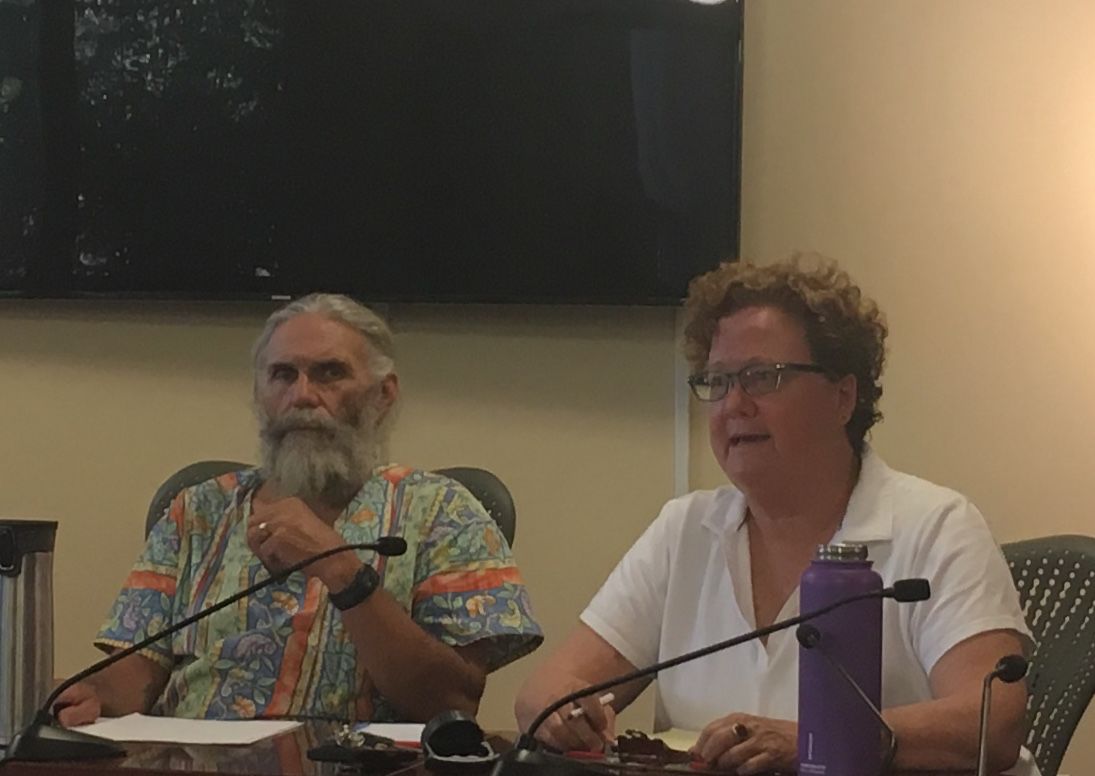Publishers’ Note: The Moab Mosquito Abatement District manager Libby Nance has recently made several public statements that may lead the public to believe our reporting has been inaccurate. While we do not believe Nance’s statements were intentionally damaging, we want the public to know that our reporting has been accurate, as well as comprehensive and fair. Please see our letter to readers at the bottom of this article.
At press time on Wednesday, July 3, the Moab Mosquito Abatement District sent out an email saying the district does plan to fog “sometime in the next three days, most likely Friday night.” The email said that due to high wind gusts Friday was the most likely time, though it is not guaranteed to occur at all.
“If and when we can fog, it will be from 9 p.m. until midnight. However, this is not a guaranteed event. The old fogger we have could very break down again, but we will give it our best.”
The email also stated, “The product we are using is completely safe and labeled for neighborhoods. If you think you need to leave town, then do so, but there is no danger from the minute amounts of active ingredient we are applying.” The statement asks that people refrain from calling the office to keep the lines open for communication with emergency officials.
On Monday, July 1, several dozen people attended the Moab Mosquito Abatement District board meeting held at the Moab City Council chambers. The board put out a press release several days prior to which stated that the meeting was “intended to be a forum to provide an opportunity for citizens to express their concerns, and for us to provide an explanation of the science involved in determining whether to spray adulticide or not, and what will be involved if we do spray.”
Board President Tim Graham told those in attendance that the district manager, Libby Nance, had tendered her resignation over the weekend. But the board had refused to accept it.
Graham said the board had “full confidence” in Nance, who is facing a slew of job-related challenges such as staffing shortages, outdated equipment and underfunding — all on top of an unusually wet year that produced a bumper crop of Aedes vexans, a species of mosquito that does not carry dangerous diseases but has plagued Moab residents nonetheless.
The mosquito nuisance has been so bad that the board had briefly suspended its policy of only spraying when a disease, such as West Nile virus, was detected. A small area of the wetlands on the western side of Moab (also called “the sloughs”), which is a breeding ground for mosquitoes, was fogged on Wednesday, June 26, with the adulticide Biomist 4+4, a synthetic mixture that includes permethrin, a compound derived from the chrysanthemum plant, and a petroleum distillate.
Shortly prior to the spraying, Nance told the Moab Sun News that the decision to include high numbers of mosquitoes as a reason to spray came in response to public feedback on the impact of the mosquito infestation. She also said then that the “silver lining” of spraying for nuisance mosquitoes was that the spraying would give the district some practice with using Biomist 4+4 and the fogging machine if West Nile virus were to be detected at a later date and the district had to fog under more urgent circumstances, with people’s lives potentially at risk.
During the July 1 meeting, Graham said the district has returned to its previous policy of not spraying for nuisance mosquitoes. He said there were a number of factors in the decision, but “the over-riding factor” was that “the vectors-of-disease mosquito species are on their way.”
He said habitat for disease-carrying species is open pools of water, of which there are many in the sloughs right now.
“We need to conserve our resources—the person-power, the larvicide and adulticide, our money—to cover that,” Graham said, adding that, “There are serious consequences if those (disease-carrying mosquito) populations get out of control.”
Graham said he understands how bad the Aedes vexans problem is, as he does field work along the Colorado River.
“My experience with mosquitoes is up close and personal,” he said.
He said the little bit of fogging that was done last week was primarily to test the decades-old fogging machine, which broke down during the spraying and had to be taken out of town for repair.
Merlene Dalton was the first citizen in attendance to address the board. She asked about the board’s “choice to spray just the sloughs.”
Nance responded by saying that the machine she inherited, which she had never operated before, was a 1970s vintage machine mounted on a 1980s vintage truck.
Nance then said she needed to start off by issuing an apology.
“I failed in my job to you,” Nance said. “I’ve tried my best, and I will continue to try my best. But this is much bigger than I am. And while I had a feeling that this was all coming—given the snowpack in the Rockies, which we monitor, and given the 40,000 cfs runoff — I had a feeling this was going to happen. And I thought I was prepared. But to answer your question, Mrs. Dalton, I didn’t want to be in a situation where public health was threatened, and I was just testing the machines for the first time. I felt like I needed that experience.”
“Why was that?” Dalton asked. “Why aren’t the machines ready to go?”
“Well, they are calibrated and ready to go. I had just never had the need to use it,” Nance replied.
“Does that mean we hadn’t ever been spraying, for years?” Dalton asked.
“I think the previous manager sprayed three years of the last 26. That’s the records I have found,” Nance answered.“And it’s his policy that I inherited.”
Nance said that the decision to spray for nuisance mosquitoes, and then the decision to not spray near neighborhoods, was hers, and that a big factor in her decision was getting a call from the hospital. Nance said the hospital told her that if she sprayed in the Bartlett neighborhood it could drift over to the hospital, and they needed an emergency plan for their air intake.
“So the compromise I made was to just try and lay down a barrier on the eastern edge of the sloughs, to try and affect the (mosquito) population in their habitat,” Nance said.
Dalton then asked if the district could spray in places like the baseball field or the city parks, pointing out that mosquitoes are not just in the sloughs but all over town. Nance replied that was too much acreage to cover for fogging to be effective. But Dalton said she remembered when “they used to do it all the time” and vehicles would come down her street to fog.
“But those were the old days,” Nance said. “We’re not in those old days anymore.”
“But isn’t your job to abate the mosquitoes?” Dalton asked.
“My job is to protect public health,” Nance responded.
She explained that she tests mosquitoes from around the district — not just in the sloughs — for disease, and also sends mosquitoes to a laboratory in Salt Lake City to be tested. If tests show the presence of disease, such as West Nile virus, present in the mosquito population, then the district would fog.
Nance also assured the audience, including several members who spoke of experiencing severe, debilitating effects from West Nile virus, that the district would immediately notify the public if West Nile virus were to be detected, and would take prompt action.
Nance also explained that the primary mosquito control that the district uses is not an aerial spray for killing adult mosquitoes (an adulticide), but a larvicide, meaning it kills immature mosquitoes in their larval stage. The larvicide is applied to the water — a safer and more effective method of control than aerial spraying.
For over an hour, various audience members addressed the board with their questions and concerns. Many of the persons who spoke were in favor of spraying in neighborhoods, and several remembered when foggers regularly drove down the roads of Moab. However, meeting attendee Audrey Graham (wife of board President Tim Graham) said that, while the majority of persons at the meeting were in favor of spraying, she knows many local people are not in favor of spraying for nuisance mosquitoes.
Nance and the board members explained that widespread fogging is not a potential strategy today, as there are concerns regarding human health and other impacts, such as to pollinators and other beneficial insects, which can be killed by insecticides along with mosquitoes, as well as aquatic life like fish and frogs.
Several audience members also expressed dismay over the lack of preparedness on the part of the district to deal with the bad mosquito year.
Graham attributed much of the current difficulty to “the previous administration of this district,” that created the situation Nance inherited in which equipment is outdated and revenue streams limited. Grand County Council member Terry Morse, who is the council representative on the abatement board, spoke to the need to raise taxes to fund the abatement district.
“This county, for 16 years, has done nothing about raising the funds that they need to operate the special service districts, the county organization that we have put together,” Morse said. “And the reason is because nobody wants higher taxes. I don’t want higher taxes. Reality is, if we want to support a community and a county like we have now and can have in the future, reality is we have to do it.”
Graham and Nance indicated that the district would be pitching a tax increase to the county council this year.
Another significant factor in the severity of the mosquito problem is the lack of staff to spread larvicide in the mosquitoes’ breeding grounds in the sloughs. The district has recently hired one new person, though Nance said they could use ten more, but do not have that in the budget. She said the district is still taking applications for Vector Control Technicians who go out into the field to monitor the mosquito population and apply larvicide.
DISTRICT HOPES FOR FUNDS TO MOUNT ‘AERIAL ASSAULT’
Nance said that if they had the funds, the plan would be to mount an “aerial assault” to spread larvicide throughout the wetlands via aircraft. However, Nance and several board members made it clear that the district does not have those funds in their budget, nor do they have an emergency fund from which to draw. Several audience members asked if the city and county would contribute money toward addressing the mosquito issue.
Nance said on Wednesday, July 3, that discussions of collaborative options are ongoing.
Publishers’ letter to readers of the Moab Sun News
The Moab Mosquito Abatement District Manager Libby Nance has recently made several public statements that may lead the public to believe our reporting has been inaccurate. While we do not believe Nance’s statements were intentionally damaging, we want the public to know that our reporting has been accurate, as well as comprehensive and fair.
Following our first article about the mosquito problem and the mosquito abatement district’s decision to spray, published to our website on June 25, Nance complimented our coverage during a phone call, and when Moab Mayor Emily Niehaus called Nance with questions, Nance referred her to our article, according to Niehaus.
However, in the days following that coverage, if the public called the Moab Mosquito Abatement District and no one picked up, the voicemail message they would have heard said the following:
“Citizens of Grand County, this is Libby at the mosquito district. Thank you for your call. Please bear with us while we get through this really difficult time. Contrary to what the public media is saying, we have decided that we are only going to focus spraying tonight, Wednesday, the 26 of June, on the eastern boundary of the sloughs. We will not be coming into the neighborhoods …”
People who listened to that message may have come away with the impression that any reporting of plans to spray near homes was inaccurate.
But, when the story first broke, Nance was very specific in saying that insecticidal spraying was planned to be near enough to homes that those inside should close their windows and turn off swamp coolers to avoid the insecticide wafting indoors. The spraying plan was amended following concerns from Moab Regional Hospital as well as members of the public who spoke out after the story was shared. As soon as we were aware that the plan had changed, our coverage was updated to reflect those changes.
Also, at the well-attended public abatement district meeting on Monday, July 1, Nance said she wanted to “correct” something that had been in the paper, and that she had “never, ever said that (previous abatement district manager) Bob Phillips was going to help us fog.”
In fact, Nance had spoken with the Moab Sun News about how she was grateful for Phillips’ involvement with the fogging project, as he was coming to calibrate the fogging machines. It was not clear whether he would or would not be involved with other aspects of the spraying operation, nor that this fact would be important to anyone. Her words about Phillips were paraphrased in a single sentence about a dozen paragraphs into our June 27 article which read, “She said Bob Phillips, the previous mosquito abatement district manager, would be assisting with this fogging operation.”
Machine calibration is an important part of the fogging operation; to say she said Phillips was assisting in the fogging operation is a sentence of fact. When this point was made at the July 2 meeting in response to her comment, Nance replied, “It’s not fake news.” But she said that Phillips didn’t see it that way, and they would appreciate the clarification. (Phillips has not contacted the Moab Sun News.)
It is fine to ask that we include the clarifying detail that the way Phillips assisted with the spraying was by calibrating the machine. And we did update the story to reflect this. However, this is not a case for which we would need to “correct” ourselves, and characterizing our coverage differently at a public meeting unfairly damages our reputation and potentially even our livelihood. We do not believe it was Nance’s intention to harm us and have no qualms with her. We simply wish to clarify. We are prepared to take responsibility for mistakes if we do make them and issue corrections in those instances, but this just isn’t one of them.
District’s planning continues to evolve
“My job is to protect public health.”





